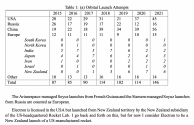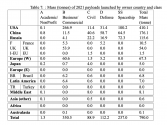The gif is 2.11m and I failed to upload it here.I don't see this posted:
On Jan 6, the Chinese space station took 47 mins to complete a test of the robotic arm. During the test, the Tianzhou2 cargo ship was detached from the core section. The robotic arm then grabbed the cargo ship, moved it from the current dock position to another side, then moved it back to attach again.
This test verifies the load capability of the robotic arm, and the procedure of moving sections (or capsules? not sure how to translate "舱段") between dock positions:
The embedded GIF animation demos the movement. But sadly the video sucks.
You are using an out of date browser. It may not display this or other websites correctly.
You should upgrade or use an alternative browser.
You should upgrade or use an alternative browser.
China's Space Program News Thread
- Thread starter crazyinsane105
- Start date
- Status
- Not open for further replies.
China has conducted a successful transposition test of its space station's cargo craft Tianzhou-2 using home-developed robotic arm early Thursday morning.
It was the first time the robotic arm operated a large space vehicle for relocation, which verified the feasibility and effectiveness of such a maneuver, China Manned Space Agency (CMSA) said on Thursday.
The transposition process took 47 minutes. After grabbing the Tianzhou-2 cargo spaceship that detached from the Tianhe core cabin at 6:12 am, the robotic arm steadily moved the craft in a counterclockwise plane direction until it eventually docked again with the core module and completed locking.
The Thursday test has preliminarily validated the feasibility and effectiveness of the robotic arm's transposition capability, verified relevant technologies, and laid a solid foundation for the busy schedules of space station construction in the new year.
China eyes 40-plus launch missions in 2022, which will include six major space-station-bound flights - two cargo ships, two manned ships and two experimental modules -- the state-owned space giant China Aerospace Science and Technology Corporation (CASC) said on Tuesday.
They will conduct in-orbit rendezvous and docking operations, space walks, and spacecraft returning missions this year, wrapping up the construction work of China's Tiangong space station.
China scored 55 orbital launches in super 2021, topping the US to become the first in the world.
Of the 55 orbital launches, 48 were from the CASC and all of them were successful, sending more than 100 spacecraft into space, and bringing a complete victory to the most ambitious aerospace year of China.
The world saw a total of 145 space launches in 2021, of which 55 were from China, 51 from the US, and 25 from Russia.
China's first ever shifting of Large Cargo SpaceCraft using Robotic arms aboard the Space Station is a success.
On January 6, according to China Manned Space Engineering Office, 6:59 Beijing time, after about 47 minutes of cross-system close coordination, the space station robotic arm transposition cargo spacecraft test was successfully completed.
In the early morning of January 6, the robotic arm successfully captured the Tianzhou-2 cargo spacecraft. The indexing test started at 6:12. After the Tianzhou-2 cargo spacecraft was unlocked and separated from the core cabin of Tianhe, it was moved by the robotic arm to perform the plane indexing with the center of the core module; then the reverse operation was conducted until the cargo spacecraft and the core compartment are docked again and locked.
This test tested the feasibility and effectiveness of using the robotic arm of the space station section transposition that would see increased usage for later operations.
On January 6, according to China Manned Space Engineering Office, 6:59 Beijing time, after about 47 minutes of cross-system close coordination, the space station robotic arm transposition cargo spacecraft test was successfully completed.
In the early morning of January 6, the robotic arm successfully captured the Tianzhou-2 cargo spacecraft. The indexing test started at 6:12. After the Tianzhou-2 cargo spacecraft was unlocked and separated from the core cabin of Tianhe, it was moved by the robotic arm to perform the plane indexing with the center of the core module; then the reverse operation was conducted until the cargo spacecraft and the core compartment are docked again and locked.
This test tested the feasibility and effectiveness of using the robotic arm of the space station section transposition that would see increased usage for later operations.
The gif is 2.11m and I failed to upload it here.
Try uploading to imgur and linking it here.
I'm not sure if this was posted already, but I've done a quick search and it didn't show up.
The Beijing-3 satellite's a 1-ton satellite with a 50cm per pixel resolution that can take photos of Earth very quickly.
The state of the art was WorldView-4, with a 30cm per pixel resolution but could only take photos much slower and with a narrower scope.
I say "was" because WorldView-4, launched in 2016, failed in 2019.
Of course these are all supposedly for civilian and commercial purposes and we really don't know what either Chinese or US spy satellites can do, but I found it interesting.
CCTV13 report, but on the SCMP youtube channel.
This is reported on other media too.
How much of the mass launch in the commercial sector is for Starlink space junk? What the hell is even Spaceship?
by78
General
A milestone. As of January 6th, 2022, the Yutu-2 lunar rover has travelled 1003.9 meters.

It has gotten closer to the mysterious spotted in early December of 2021. It turns out to be a large rock on the edge of a crater. The rover will next perform a close examination of the rock and the impact crater behind it.




It has gotten closer to the mysterious spotted in early December of 2021. It turns out to be a large rock on the edge of a crater. The rover will next perform a close examination of the rock and the impact crater behind it.



So China is launching vastly more in tonnage than the US, even more than the moderately higher gross orbital launch attempts indicate, with one big exception... The US launches hundreds of tons of Starlink satellites. 19 launches in 2021 and each one averaged a payload of 13 to 15 tons. So B (Business/Commercial) is close to 100% just Starlink junk for high latency internet for rural areas.
As for SS (Spaceship) what does that even mean. It's the only other area where China is a laggard, but it still launched two thirds of the US total so not bad.
As for the rest, China launched 8x as much in academic/nonprofit tonnage, almost 4x as much in civil tonnage, and almost 2x as much in defense payload (!).
I suspect some of what is classified as civil under China would have been classified as commercial in the U.S. For example I suspect navigation satellites would have been classified as commercial in the US but civil in China.
- Status
- Not open for further replies.


